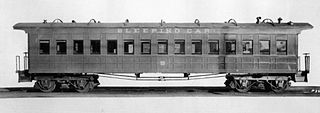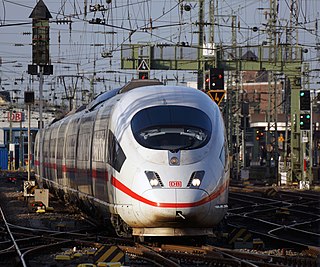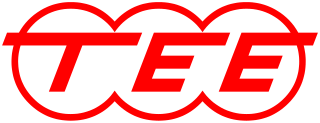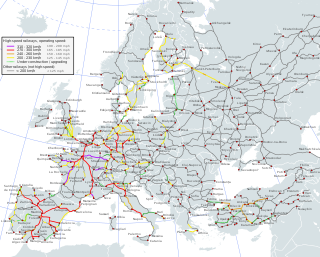Related Research Articles

The sleeping car or sleeper is a railway passenger car that can accommodate all passengers in beds of one kind or another, for the purpose of sleeping. George Pullman was the American innovator of the sleeper car.

As of 2021, Germany had a railway network of 33,399 kilometres (20,753 mi), of which 20,540 kilometres (12,760 mi) were electrified and 18,556 kilometres (11,530 mi) were double track. Germany is a member of the International Union of Railways (UIC). The UIC Country Code for Germany is 80.

EuroCity (EC) is an international train category and brand for European inter-city trains that cross international borders and meet criteria covering comfort, speed, food service, and cleanliness. Each EC train is operated by more than one European Union or Swiss rail company, under a multilateral co-operative arrangement, and all EC trains link important European cities with each other.

The Trans Europ Express, or Trans-Europe Express (TEE), was an international first-class railway service in western and central Europe that was founded in 1957 and ceased in 1995. At the height of its operations, in 1974, the TEE network comprised 45 trains, connecting 130 different cities, from Spain in the west to Austria in the east, and from Denmark to Southern Italy.

Compagnie Internationale des Wagons-Lits is a Belgian-founded French company known for providing and operating luxury trains with sleepers and dining cars during the late 19th and the 20th centuries, most notably the Orient Express. Founded by Georges Nagelmackers in 1872, CIWL developed an international network of trains beginning in Europe, and later expanding to Asia and Africa. The trains provided luxury and comfort at a time when travelling was still rough and dangerous. The Armistice with Germany was signed in a CIWL train carriage, the Compiègne Wagon, on November 11, 1918.

Caledonian Sleeper is the collective name for overnight sleeper train services between London and Scotland, in the United Kingdom. It is one of only two currently operating sleeper services on the railway in the United Kingdom, the other being the Night Riviera which runs between London and Penzance.

The Venice Simplon-Orient-Express (VSOE) is a private luxury train service from London to Venice and other European cities. It is currently owned by Belmond.

City Night Line, abbreviated CNL, was a train category of German railway company Deutsche Bahn for overnight passenger train services between Germany and neighbouring European countries. In late 2015, Deutsche Bahn announced that it planned to terminate all night train services in December 2016, and this plan was implemented on 11 December 2016. The service on some CNL routes was replaced by ÖBB Nightjet services.
The Nightstar was a proposed overnight sleeper train service from various parts of the United Kingdom to destinations in mainland Europe, via the Channel Tunnel, in the mid 1990s. To run alongside the Eurostar, and north of London day-time Regional Eurostar services which were never operational, the Nightstar was the last part in a proposed round-the-clock passenger train utilisation of the Channel Tunnel.

Rail transport in Europe has diverse technological standards, operating concepts, and infrastructures. Common features are the widespread use of standard-gauge rail, high operational safety and a high share of electrification. Electrified railway networks operate at many different voltages, both AC and DC, varying from 750 to 25,000 volts, and signaling systems vary from country to country, complicating cross-border traffic.

High-speed rail (HSR) has developed in Europe as an increasingly popular and efficient means of transport. The first high-speed rail lines on the continent, built in the 1970s, 1980s, and 1990s, improved travel times on intra-national corridors.

In rail transport, an open-access operator is an operator that takes full commercial risk, running on infrastructure owned by a third party and buying paths on a chosen route and, in countries where rail services run under franchises, are not subject to franchising.

Cambodia has 612 km (380 mi) of 1,000 mm metre gauge rail network, consisting of two lines: one from the capital, Phnom Penh, to Sihanoukville, and another from Phnom Penh to Poipet, on the Thai border. The lines were originally constructed during the time when the country was part of French Indochina, but due to neglect and damage from civil war during the latter half of the 20th century, the railways were in a dilapidated state, and all services had been suspended by 2009. Through rehabilitation efforts by the government of Cambodia, with funding from the Asian Development Bank, Australian Agency for International Development (AusAID), and the Australian company Toll Holdings, freight and limited passenger service returned between Phnom Penh and Sihanoukville by 2016, and passenger service between Phnom Penh and Poipet was fully restored in 2019.
The Single European Railway Directive 2012 is an EU Directive that regulates railway networks in European Union law. This recast the "First Railway Directive" or "Package" from 1991, and allows open access operations on railway lines by companies other than those that own the rail infrastructure. The legislation was extended by further directives to include cross border transit of freight.

France has a large network of high-speed rail lines. As of June 2021, the French high-speed rail network comprises 2,800 km (1,740 mi) of tracks, making it one of the largest in Europe and the world. As of early 2023, new lines are being constructed or planned. The first French high-speed railway, the LGV Sud-Est, linking the suburbs of Paris and Lyon, opened in 1981 and was at that time the only high-speed rail line in Europe.
Trenitalia France is an open-access train operator running international services between France and Italy. It was originally established under the Thello brand in October 2011.

The Komet was an international overnight express train service between Germany and Switzerland, which was in operation from 1954 to 2016. Its name reflected the notion that the Comet train and an actual comet can both be described as travelling through the night at high speed. It was introduced in 1954. It became a EuroCity (EC) service upon the launch of the EC network in 1987. It became categorised as CityNightLine (CNL) service in the mid-1990s. With the decision by Deutsche Bahn to terminate all CNL services in December 2016, the Komet ran for the last time on 10–11 December 2016.

Nightjet is a brand name given by the Austrian Federal Railways (ÖBB) to its overnight passenger train services.

FlixTrain is a German open-access operator of long-distance railway services. It is a subsidiary of the mobility company Flix SE, which also owns long-distance coach operator FlixBus and is supplementing the bus network with rail connections.

European Sleeper is a Belgian-Dutch cooperative which operates a thrice-weekly open-access night train service between Brussels and Prague, with plans to expand to daily service in the near future. There are also plans for services linking Amsterdam, Brussels and Barcelona via France, expected to commence during the spring of 2025.
References
- ↑ "French start-up promises 'hotel on wheels' with overnight trains". 15 June 2021.
- ↑ Hardingham-Gill, Tamara (24 June 2021). "'Hotels on rails': Plans for new network of European sleeper trains unveiled". CNN.
- ↑ Flynn, David (16 June 2021). "Midnight Trains aims to reinvent sleeper trains as a 'hotel on rails'". Executive Traveller.
- ↑ "Midnight Trains | Our story". www.midnight-trains.com. Retrieved 12 May 2024.
- ↑ "New network of European sleeper trains announced". The Guardian. 22 June 2021.
- ↑ Burroughs, David (15 June 2021). "French start-up promises "hotel on wheels" with overnight trains". International Railway Journal. Retrieved 24 September 2021.
- ↑ Timothy (9 January 2023). "Midnight Trains secures new night train rolling stock, aims for December 2024 start". Trip By Trip. Retrieved 30 May 2023.
- ↑ "Connecting Europe by train: 10 EU pilot services to boost cross-border rail". transport.ec.europa.eu. Retrieved 29 May 2023.
- ↑ Walton, Simon (1 December 2023). "Midnight Trains drops plans for Edinburgh to Paris sleeper". RailTech.